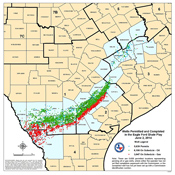Eagle Ford Shale Geological Area
The Eagle Ford Shale is a hydrocarbon-producing geological formation extending over 26 counties. It stretches from the Mexican border between Laredo and Eagle Pass up through counties east of Temple and Waco.
Background
The TCEQ’s primary role in the oil and gas fields is regulating emissions and ensuring air quality. Working with the Railroad Commission, which has primary jurisdiction over oil and gas facilities in Texas, the TCEQ is devoting significant resources to make sure those responsibilities are met. Based on lessons learned from the TCEQ’s work in the Barnett Shale area, numerous activities have already been conducted or will soon take place to help the agency remain in front of any environmental issues in the Eagle Ford Shale area.
The TCEQ continues to use innovative approaches to find ‘real world solutions’ that actually reduce emissions. The TCEQ has undertaken numerous projects that use state-of-the-science technology to assess and address emissions from oil and gas activities. These initiatives have resulted in emissions reductions through improved agency policies, guidance for regulated entities and possible enforcement if necessary.

Air Monitoring
Near-real-time air monitoring results from the agency’s air monitors located in the Eagle Ford Shale area:
Floresville Hospital Boulevard (Wilson County) Ambient Monitoring Station
- Automated Gas Chromatograph (AutoGC) data
- Floresville Hospital Boulevard Site Information including near-real-time nitrogen oxides and meteorological data
Karnes County Courthouse Ambient Monitoring Station
- AutoGC data
- Karnes County Site Information including near-real-time nitrogen oxides, hydrogen sulfide and meteorological data
Sampling Results and Health Effects Evaluations by County
TCEQ laboratory analysis, listed by county, of air sampling conducted near oil and/or natural gas facilites in the Eagle Ford Shale area. Health effects evaluations for air sampling results are posted as they become available.
24-Hour Canister Monitoring
The Texas Air Monitoring Information System (TAMIS)
TAMIS is a TCEQ Web interface that can generate a report showing VOC data collection at the 24-hour Laredo Bridge canister in Webb County.
Air Monitoring Comparison Values
AMCV is a collective term used to describe chemical-specific air concentrations used to evaluate air monitoring data that are set to protect human health and welfare. Ambient air monitoring results are compared to AMCVs to determine whether exposure to the measured concentrations have the potential to cause adverse health effects, odors, or vegetation effects.
Eagle Ford Shale Mobile Monitoring Study
TCEQ has funded a Mobile Monitoring Study of upwind and downwind monitoring of VOCs and NOx concentrations to evaluate any significant differences in the concentration of ozone precursors.
Related Links
- TCEQ Compliance tools for oil and gas facilities in Texas
- Eagle Ford Shale information from Railroad Commission of Texas
- Barnett Shale Geological Area
- Geographical Texas Air Monitoring (GeoTAM)
- How do I make an environmental complaint?
- Compliance history of regulated entities
Latest Activities
New Karnes County Courthouse Ambient Monitoring Station:
Karnes County Automated Gas Chromatograph
(AutoGC) data
Karnes County Site Information
Eagle Ford Map
Map provided by the Texas Railroad Commission .

